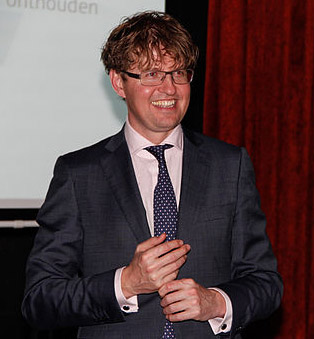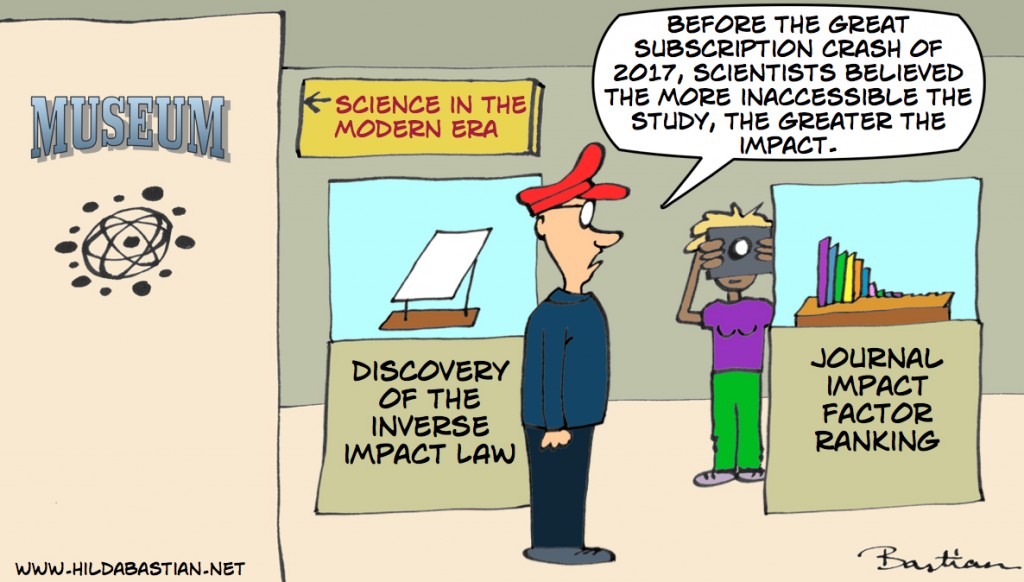Open Access 2015: A Year Access Negotiators Edged Closer to the Tipping Point
 Hilda BastianIt’s the year many negotiators got seriously tough on double dipping – charging for both the ability to read (via subscriptions) and for publishing (author processing charges, or APCs). Last year it was France getting tough on the toughest negotiator: Elsevier. This year, the Netherlands took it right to the brink of cutting Elsevier loose. It was summed up by a January headline: “Dutch universities dig in for long fight over open access”.
Hilda BastianIt’s the year many negotiators got seriously tough on double dipping – charging for both the ability to read (via subscriptions) and for publishing (author processing charges, or APCs). Last year it was France getting tough on the toughest negotiator: Elsevier. This year, the Netherlands took it right to the brink of cutting Elsevier loose. It was summed up by a January headline: “Dutch universities dig in for long fight over open access”.
Coming into the new year, other nations were taking up positions about the future they want to see too – for example, major Austrian science funders plumped for a non-commercial open access future. And some universities and consortia of universities set up open access publishing operations – like the University of California Press’ Collabra. Here’s an explanation the thinking behind the system developed by 5 Dutch universities: OPuS.
Here’s a month-by-month roundup of some of the major action.
 January
January
Dutch negotiators announced their 2-year deal with Springer [PDF]. Instead of a subscription model for 1,900 journals, they bulk-bought publishing rights in them for Dutch researchers.
The result: authors pay no APC. (BioMed Central was excluded, as there were no subscription charges.) Elsevier status? “No breakthrough”, they reported [PDF]. But talks with Wiley, Sage, and Oxford University Press resumed.
EU funded a project by 43 partners to help guide Europe into an Open Science Commons.
It was also the second birthday of f1000 Research – one of the open science publishing systems that break away from conventional journal systems. It’s a publish first, peer review later, model. Over 2,200 authors had published articles, posters, or slides there.
February
A group of major German science organizations and university libraries spelled out their position on the path to open access: towards fully open access journals, rather than encouraging commercial hybrid publishing [PDF].
Is an “all-scholarship repository” for research a feasible option? That’s part of the line of thought the non-profit National Science Communication Institute is mulling over, with the Los Alamos National Laboratory.
And more open data on expenditure on open access: this time the Austria Science Fund’s expenditure in 2014.
 David Carroll and Joseph McArthur, co-founders of the Open Access Button, won the SPARC Innovator Award click for more info)March
David Carroll and Joseph McArthur, co-founders of the Open Access Button, won the SPARC Innovator Award click for more info)March
What’s an effective open access policy? This analysis concluded it includes mandatory depositing of articles – with real consequences for researchers in the future if they don’t do it.
That’s the line the U.S. government has been heading down for research funded by its agencies – albeit allowing a 12-month embargo. The National Science Foundation (NSF) announced its new obligations – to come in force from January 2016 [PDF]. (Columbia University keeps a list of what’s happening with U.S. agencies here.)
There are major consequences for researchers, too, in the final policy of the Higher Education Funding Council for England’s (HEFCE) (updated later in July). Only open access articles can be submitted as evidence of university excellence in evaluation for base funding.
Only a short time after the start of its open access policy, the UK’s Research Councils published a review [PDF]. They’re trying to find a way to reduce financial and administrative burdens. And Springer struck a deal to cap the subscription + APC costs to journals for UK universities.
Agreements from informal discussions between the Netherlands and the UK on open access were released – including a call for European-wide regulation of open access.
In Rome, people running institutions’ repositories for open access articles and data internationally gathered to workshop on ways to improve and network repositories.
 Meanwhile, there was more news from the negotiating team at the VSNU, the Association of Universities in the Netherlands: some progress with Wiley, Sage, and Oxford University Press. But negotiations with Elsevier were now on hold:
Meanwhile, there was more news from the negotiating team at the VSNU, the Association of Universities in the Netherlands: some progress with Wiley, Sage, and Oxford University Press. But negotiations with Elsevier were now on hold:
“Elsevier is only willing to move towards open access if the universities pay for both the right to read and the right to publish articles. This would not be feasible in budgetary terms.”
 At Stationers’ Hall, East London – the Guild that achieved copyright in England in the 18th century (Photo by Hilda Bastian, April 2015).April
At Stationers’ Hall, East London – the Guild that achieved copyright in England in the 18th century (Photo by Hilda Bastian, April 2015).April
More funders’ organizations signed up to an open access policy: this time, Science Europe.
More open access publishing infrastructure: eLife, a major funder initiative, released eLife Lens. It’s open source publishing software to enable people to self-host a science journal.
More signs, too, of the intense effort going into negotiating better deals: UK universities released Principles for Offset Agreements.
And the news from Netherlands negotiators: progress with Wiley – but not Elsevier or Sage [PDF].
Elsevier, meanwhile, unleashed the power of Doublespeak with a policy paper called “Unleashing the power of academic sharing that was all about restrictions – especially on author-deposited manuscripts. More on this here from Ginny Barbour.
Support for the Dutch position came from Germany’s Max Planck Digital Society, with a paper titled: “Disrupting the subscription journals’ business model for the necessary large-scale transformation to open access”.
May
A dramatic start to the month as a dispute with Elsevier over open access at the Medical Journal of Australia erupted publicly: Stephen Leeder, the editor-in-chief was sacked. Most of the advisory board and deputy editors resigned in protest.
More drama: Russian researchers lost access to Springer journals. The cost had become prohibitive.
Another report from the Dutch negotiators reported some progress with Sage – and showed support for the Max Planck paper [PDF].
In other news, UCL announced that it had launched “the UK’s first fully open University Press”. And the Council of the European Union concluded that “open, data-intensive and networked research [are] a driver for faster and wider innovation” [PDF].
And a poetic end to the month: the Journal of British and Irish Innovative Poetry became the first journal to flip to open access in the innovative emerging Open Library of Humanities.
 June
June
An analysis of digital academic publishing from 1973 to 2013 found that 50% of all papers published in 2013 came from 5 publishers – and Elsevier, Wiley, Springer and Taylor & Frances had all been increasing their share of the market. And Stuart Lawson’s dataset of subscription costs being paid to publishers added data for Nature, RSC, and IOP. (Read more from Lawson here.)
The Dutch universities released a fact sheet called, “Elsevier open access negotiations in deadlock: academics must act” [PDF]:
“[We] seriously consider a possible scenario in which no new agreement will be reached with Elsevier. Preparations are underway to cope with this possible scenario. It is likely that we will face this challenge from 1 January 2016 onwards…It is important that researchers work together, nationally and internationally, to put pressure on publishers, supporting the joint position of the Dutch universities. Applying pressure will limit the transition period to open access and that in turn will save money. Eventually, open access will lead to better use of public funds and greater access to knowledge. Open access publishing is the future!”
Elsevier started legal action to stop Sci-Hub and others’ release of non-open access scientific literature. The Court later upheld their claim – but the services resurfaced.
In Germany, the new form for applying for funds for APCs under German Research Foundation (DFG) grants excluded hybrid journals.
And another way the open access rubber hits the road: a study concluded that open access articles were more likely to be linked to on Wikipedia. (SPARC Europe maintains a list of articles on what open access does to article citations (it increases them).
 Sander Dekker, the Dutch Undersecretary for Education, Culture and Science – the driver of national open access policy (in 2014, photo by Richard Broekhuijzen in Wikimedia Commons)July
Sander Dekker, the Dutch Undersecretary for Education, Culture and Science – the driver of national open access policy (in 2014, photo by Richard Broekhuijzen in Wikimedia Commons)July
A change to Dutch copyright law came into effect. It enshrines the right of publicly funded researchers to: “make that work available to the public for no consideration following a reasonable period of time after the work was first published”. (It’s based on a provision in German copyright law, but it goes further.)
Dutch negotiators announce a deal with Sage: partially publishing service prepaid by universities, and discounted rates mean no APCs for researchers. Negotiations with Elsevier? “Deadlocked” [PDF]. And they approached Dutch 46 editors-in-chief and 835 associate editors of Elsevier journals, asking them to leave those posts if no deal is struck with Elsevier.
Greek researchers lost large-scale access to subscription scientific journals. (More on this here.)
August
The image of open access publishing is improving, according to a survey of 22,000 academic researchers by Nature/Macmillan.
A report to UK universities found that open access was increasing university costs – by adding APCs to subscription costs.
 In September, the groundbreaking Open Library of Humanities launched (click on image for more info; photo by torbakhopper)September
In September, the groundbreaking Open Library of Humanities launched (click on image for more info; photo by torbakhopper)September
Lots of interesting data came to light around a legal action in Switzerland that ended up safeguarding a library’s right to share scientific articles widely. Zurich’s library was paying $3.7 million for Elsevier subscriptions that were only about $2.5 million for Cornell, for example.
Also in Switzerland: CERN reached an open access deal with Elsevier.
This was the month that PLOS raised the cost of its APCs, to the consternation of many.
October
The Wellcome Trust released a gorgeous, open source 10-year timeline of open access since their own groundbreaking open access mandate of 2005.
The entire editorial staff and board of an influential Elsevier linguistics journal resigned and started a new open access journal. At issue: Elsevier’s refusal to dramatically reduce author processing charges (APC).
News from the Netherlands: negotiating again with Elsevier – and now started to talk with Kluwer, Taylor & Francis, and the American Chemical Society (ACS) [PDF].
Jon Tennant and Ross Mounce spearheaded the community development of an open research glossary.
The European Commissioner called on scientific publishes to adapt their models to account for new realities in research funding and costs.
And the League of European Universities (LERU) didn’t mince their words in launching their statement on open access [PDF]:
“Christmas is over! Research funding should go to research, not to publishers!”
 November
November
NWO, the Netherlands Organisation for Scientific Research, released a more stringent open science policy: publications from research they fund have to be publicly available as soon as they are published – no embargo at all. But wait – that’s not all! They also established a small funding stream for replication studies. And foreshadowed policies on open data management.
December: The European Commission announced it’s setting up an Open Science Platform, “to develop open science policy through a structured discussion with stakeholders” [PDF].
A group of researchers launched the Peer Reviewer’s Openness Initiative (PRO), with an article published by the Royal Society [PDF]. Researchers, they argue, should withhold comprehensive peer review until they are satisfied on key aspects of openness. The PRO group set 1 January 2017 as the date from which they want a large-scale move to this commitment.
And the year’s Dutch nail biter ended when Elsevier blinked at the last minute: access to Elsevier journals would continue – but there wasn’t a lot of detail yet [PDF]. It’s a 3-year deal, and again, Dutch researchers won’t have to pay APCs for whichever Elsevier journals will be covered. The negotiators say they will raise the bar higher for 2018. And a deal with Wiley was in the works as well [PDF].
What’s next in 2016? The push for universities to take over publishing will be a major trend to watch in 2016. For Utrecht University, for example, this was a kind of slippery slope – for others it will be a strategic goal.
And the Netherlands holds the EU Presidency in 2016 – and open science, including open access to publications and data, will be one of their priorities. The momentum we’ve been seeing the last couple of years doesn’t look likely to end soon.
~~~~
 Previous annual open access roundups: 2014 and 2013.
Previous annual open access roundups: 2014 and 2013.
The cartoons in this post, as well as the photo from the Stationers’ Hall in London, are my own (CC-NC-ND-SA license). (More at Statistically Funny and on Tumblr.)
The photo of science journals in a library is by Vmenkov at Wikimedia Commons: it’s the library of the University of the Basque Country (Vitoria-Gasteiz).
The photo of Sander Dekker, Netherlands Undersecretary for Education, Culture and Science, was taken in Emmen in 2014 by Richard Broekhuijzen (via Wikimedia Commons).
“Where books still soar in the imagination”, photo by torbakhopper taken at North Beach, San Francisco in 2012 (via flickr).
* The thoughts Hilda Bastian expresses here at Absolutely Maybe are personal, and do not necessarily reflect the views of the National Institutes of Health or the U.S. Department of Health and Human Services.
| Open Access 2015: A Year Access Negotiators Edged Closer to the Tipping Point was authored by Hilda Bastian and published in PLOS Blogs. It is being republished by Open Health News under the terms of the Creative Commons Attribution (CC BY) license. The original copy of the article can be found here. |
- Tags:
- access publishing infrastructure
- all-scholarship repository
- American Chemical Society (ACS)
- Association of Universities in the Netherlands (VSNU)
- Austria Science Fund
- Austrian science funders
- author processing charges (APC)
- CERN
- Columbia University
- Council of the European Union
- David Carroll
- digital academic publishing
- Dutch researchers
- Dutch universities
- eLife Lens
- Elsevier
- Elsevier linguistics journal
- European-wide regulation of open access
- F1000 Research
- France
- German Research Foundation (DFG)
- German science organizations
- German university libraries
- Germany
- Ginny Barbour
- Higher Education Funding Council for England’s (HEFCE)
- Hilda Bastian
- Jon Tennant
- Joseph McArthur
- Journal of British and Irish Innovative Poetry
- Kluwer
- League of European Universities (LERU)
- Los Alamos National Laboratory
- Max Planck Digital Society
- Medical Journal of Australia
- National Science Communication Institute
- National Science Foundation (NSF)
- Netherlands
- Netherlands Organisation for Scientific Research (NWO)
- open access (OA)
- Open Access 2015
- Open Access Button
- Open Access Policy
- open access publishing operations
- Open Data
- open data management
- Open Library of Humanities
- open research glossary
- Open Science Commons
- Open Science Platform
- open science publishing systems
- open source publishing software
- OPuS
- Peer Reviewer’s Openness Initiative (PRO)
- PLoS
- Principles for Offset Agreements
- Ross Mounce
- Royal Society
- Sander Dekker
- Science Europe
- self-hosting a science journal
- SPARC Europe
- SPARC Innovator Award
- Springer
- Stephen Leeder
- Stuart Lawson
- Taylor & Frances
- UK’s Research Councils
- University of California Press
- Utrecht University
- Wellcome Trust
- Wikipedia
- Wiley
- Login to post comments